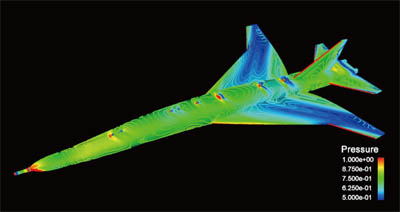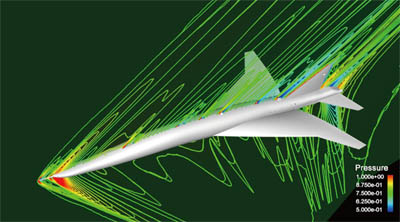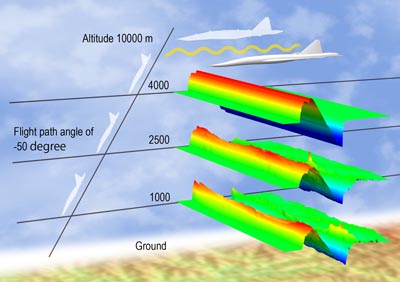D-SEND Project
Numerical Simulation of D-SEND#2 Airplane
JAXA Aeronautical Technology Directorate is promoting a supersonic transport(SST) research program named “R&D for System integration of Silent SuperSonic(S4) airplane technologies” for low noise SST design technologies. One of the targets of this program is to develop the technologies for reducing sonic-booms to meet an expected future noise standard. Some low sonic-boom design concepts are studied and applied to a 50-passenger aircraft configuration which is defined as a technology reference aircraft and its sonic-boom intensities are compared to those of a conventional Concorde-like SST configuration. In order to demonstrate these low sonic-boom concepts and design technologies, a low-boom demonstration flight using a scaled non-powered experimental airplane named D-SEND#2 was conducted in July, 2015. In the design of the D-SEND#2 airplane, an effective and accurate sonic-boom prediction tool was required and a CFD tool for near-field pressure signature prediction by combining a structured and unstructured CFD codes was developed.
Job Characteristics
- CPU time: 3 hours
- Number of cases: 50 cases
- Number of processes per job: 15~200 processes
- Number of cores per process: 4~32 cores
- Parallelization method: Hybrid(MPI+Fujitsu compiler)
- Compiler: Fujitsu compiler with automatic thread parallelization
- System used for jobs: SORA-MA

Pressure distribution on the D-SEND#2 airplane surface

Shock waves from the D-SEND#2 airplane simulated
for sonic-boom prediction
Movie of the numerical simulation of D-SEND#2
Numerical Simulation of the Effect of Atmospheric Turbulence on Sonic Boom
The shape of waveform changes during the propagation from high altitude to the ground.
Deformation of waveform is especially enhanced when injected into the atmospheric boundary layer, resulting in a peaky or rounded waveform.
Such a deformation is often referred to as the effect of atmospheric turbulence since the effect comes from a disturbances of the atmospheric turbulence within the layer.
Numerical Simulation Research Unit developed a numerical prediction tool for the effect of atmospheric turbulence and proved that the observed waveform in the D-SEND#2 flight test was a consequence of the effect of atmospheric turbulence.
Job Characteristics
- CPU time: 1 hours
- Number of cases: 100 cases
- Number of cores per process: 12~36 cores
- Parallelization method: Hybrid(MPI+Fujitsu compiler)
- Thread parallelization methods: OpenMP
- System used for jobs: Dell Workstation

Deformation of waveform
Movie of the deformation of waveform
More information about D-SEND Project
- D-SEND project / Silent supersonic transport technology
- Silent Supersonic Technology Demonstration Program- D-SEND#2 Test Results –(Movie)


